IMERG V07B and V06B: A Comparative Study of Precipitation Estimates Across South America with a Detailed Evaluation of Brazilian Rainfall Patterns
Abstract
1. Introduction
2. Materials and Methods
2.1. Study Area and Characterization of Precipitation Regimes
2.2. Ground-Based Observations
2.3. IMERG Satellite Data
2.4. Statistical and Categorical Indices
3. Results
3.1. Comparison of IMERG V06B and V07B over South America
3.2. Assessment of the Performance of IMERG V06B and V07B Versions over Brazil
3.3. Region R1
3.4. Region R2
3.5. Region R3
3.6. Region R4
3.7. Region R5
4. Discussion
4.1. Comparative Analysis of IMERG Versions V06B and V07B
4.2. Performance of IMERG Versions V06B and V07B in Different Precipitation Regimes
5. Conclusions
- (1)
- Both IMERG versions effectively capture the seasonal precipitation patterns associated with key precipitation systems active in South America, including the SACZ, ITCZ, and MCS;
- (2)
- The most significant discrepancies between the two versions are observed over oceanic regions and continental areas lacking gauge data, with V06B consistently estimating higher rainfall volumes than V07B. In contrast, these differences are less pronounced over land;
- (3)
- During the winter months in the eastern region of Northeast Brazil, where SPPs face challenges in estimating precipitation associated with warm cloud tops, version V07B tends to further underestimate precipitation volumes;
- (4)
- Over the years, particularly over oceanic regions, V06B has shown a trend of decreasing precipitation volume, a pattern not observed in V07B;
- (5)
- In general, RMSE values for version V07B are lower than those for version V06B in all analyzed regions;
- (6)
- In regions R1, R2, and R5, both versions tend to overestimate the rain/no-rain and light rainfall classes, while for moderate rainfall the BIAS approaches 1.0. Other dichotomous indices, such as POD, FAR, and CSI, indicate a superior performance by V07B;
- (7)
- Regions R3 (winter) and R4 (winter and spring) exhibited the most unfavorable results for both versions, with extremely low POD and CSI values, high FAR indices, and pronounced underestimation across all precipitation classes. In these regions and seasons, version V07B performs worse than V06B, further intensifying the underestimations;
- (8)
- From the perspective of ETSa, which eliminates the effect of BIAS, version V07B demonstrated a superior performance to V06B in most situations, was equivalent in some, but was never inferior.
Author Contributions
Funding
Data Availability Statement
Acknowledgments
Conflicts of Interest
References
- Trenberth, K.E.; Dai, A.; Rasmussen, R.M.; Parsons, D.B. The Changing Character of Precipitation. Bull. Am. Meteorol. Soc. 2003, 84, 1205–1218. [Google Scholar] [CrossRef]
- Mitchell, J.F.B.; Wilson, C.A.; Cunnington, W.M. On Co2 Climate Sensitivity and Model Dependence of Results. Q. J. R. Meteorol. Soc. 1987, 113, 293–322. [Google Scholar] [CrossRef]
- Sherwood, S.; Fu, Q. A Drier Future? Science 2014, 343, 737–739. [Google Scholar] [CrossRef] [PubMed]
- Kelley, O.A. Where the Least Rainfall Occurs in the Sahara Desert, the TRMM Radar Reveals a Different Pattern of Rainfall Each Season. J. Clim. 2014, 27, 6919–6939. [Google Scholar] [CrossRef]
- Schween, J.H.; Hoffmeister, D.; Löhnert, U. Filling the Observational Gap in the Atacama Desert with a New Network of Climate Stations. Glob. Planet. Chang. 2020, 184, 103034. [Google Scholar] [CrossRef]
- Knox, R.; Bisht, G.; Wang, J.; Bras, R. Precipitation Variability over the Forest-to-Nonforest Transition in Southwestern Amazonia. J. Clim. 2011, 24, 2368–2377. [Google Scholar] [CrossRef]
- New, M.; Todd, M.; Hulme, M.; Jones, P. Precipitation Measurements and Trends in the Twentieth Century. Int. J. Climatol. 2001, 21, 1889–1922. [Google Scholar] [CrossRef]
- Xu, L.; Chen, N.; Moradkhani, H.; Zhang, X.; Hu, C. Improving Global Monthly and Daily Precipitation Estimation by Fusing Gauge Observations, Remote Sensing, and Reanalysis Data Sets. Water Resour. Res. 2020, 56, e2019WR026444. [Google Scholar] [CrossRef]
- Kummerow, C.; Barnes, W.; Kozu, T.; Shiue, J.; Simpson, J. The Tropical Rainfall Measuring Mission (TRMM) Sensor Package. J. Atmos. Ocean. Technol. 1998, 15, 809–817. [Google Scholar] [CrossRef]
- Kubota, T.; Shige, S.; Hashizume, H.; Aonashi, K.; Takahashi, N.; Seto, S.; Hirose, M.; Takayabu, Y.N.; Ushio, T.; Nakagawa, K.; et al. Global Precipitation Map Using Satellite-Borne Microwave Radiometers by the GSMaP Project: Production and Validation. IEEE Trans. Geosci. Remote Sens. 2007, 45, 2259–2275. [Google Scholar] [CrossRef]
- Hou, A.Y.; Kakar, R.K.; Neeck, S.; Azarbarzin, A.A.; Kummerow, C.D.; Kojima, M.; Oki, R.; Nakamura, K.; Iguchi, T. The Global Precipitation Measurement Mission. Bull. Am. Meteorol. Soc. 2014, 95, 701–722. [Google Scholar] [CrossRef]
- Sharifi, E.; Steinacker, R.; Saghafian, B. Assessment of GPM-IMERG and Other Precipitation Products against Gauge Data under Different Topographic and Climatic Conditions in Iran: Preliminary Results. Remote Sens. 2016, 8, 135. [Google Scholar] [CrossRef]
- Boluwade, A.; Stadnyk, T.; Fortin, V.; Roy, G. Assimilation of Precipitation Estimates from the Integrated Multisatellite Retrievals for GPM (IMERG, Early Run) in the Canadian Precipitation Analysis (CaPA). J. Hydrol. Reg. Stud. 2017, 14, 10–22. [Google Scholar] [CrossRef]
- Ruhi, A.; Messager, M.L.; Olden, J.D. Tracking the Pulse of the Earth’s Fresh Waters. Nat. Sustain. 2018, 1, 198–203. [Google Scholar] [CrossRef]
- Papalexiou, S.M.; Montanari, A. Global and Regional Increase of Precipitation Extremes Under Global Warming. Water Resour. Res. 2019, 55, 4901–4914. [Google Scholar] [CrossRef]
- Jones, J.A.; Trahel, V.; Hakopian, C. Threats to Global Water Security; Springer Science & Business Media: Berlin/Heidelberg, Germany, 2009; ISBN 978-90-481-2344-5. [Google Scholar]
- Dalin, C.; Wada, Y.; Kastner, T.; Puma, M.J. Groundwater Depletion Embedded in International Food Trade. Nature 2017, 543, 700–704. [Google Scholar] [CrossRef]
- Huffman, G.J.; Bolvin, D.T.; Braithwaite, D.; Hsu, K.; Joyce, R.; Xie, P.; Yoo, S.H. NASA Global Precipitation Measurement (GPM) Integrated Multi-Satellite Retrievals for GPM (IMERG). Algorithm Theor. Basis Doc. Version 2015, 4, 2020-05. [Google Scholar]
- Aonashi, K.; Awaka, J.; Hirose, M.; Kozu, T.; Kubota, T.; Liu, G.; Shige, S.; Kida, S.; Seto, S.; Takahashi, N.; et al. GSMaP Passive Microwave Precipitation Retrieval Algorithm: Algorithm Description and Validation. J. Meteorol. Soc. Jpn. Ser II 2009, 87A, 119–136. [Google Scholar] [CrossRef]
- Joyce, R.J.; Janowiak, J.E.; Arkin, P.A.; Xie, P. CMORPH: A Method That Produces Global Precipitation Estimates from Passive Microwave and Infrared Data at High Spatial and Temporal Resolution. J. Hydrometeorol. 2004, 5, 487–503. [Google Scholar] [CrossRef]
- Hsu, K.; Gao, X.; Sorooshian, S.; Gupta, H.V. Precipitation Estimation from Remotely Sensed Information Using Artificial Neural Networks. J. Appl. Meteorol. 1997, 36, 1176–1190. [Google Scholar] [CrossRef]
- Huffman, G.J.; Bolvin, D.T.; Nelkin, E.J.; Wolff, D.B.; Adler, R.F.; Gu, G.; Hong, Y.; Bowman, K.P.; Stocker, E.F. The TRMM Multisatellite Precipitation Analysis (TMPA): Quasi-Global, Multiyear, Combined-Sensor Precipitation Estimates at Fine Scales. J. Hydrometeorol. 2007, 8, 38–55. [Google Scholar] [CrossRef]
- Funk, C.; Peterson, P.; Landsfeld, M.; Pedreros, D.; Verdin, J.; Shukla, S.; Husak, G.; Rowland, J.; Harrison, L.; Hoell, A.; et al. The Climate Hazards Infrared Precipitation with Stations—A New Environmental Record for Monitoring Extremes. Sci. Data 2015, 2, 150066. [Google Scholar] [CrossRef] [PubMed]
- Adler, R.F.; Huffman, G.J.; Chang, A.; Ferraro, R.; Xie, P.-P.; Janowiak, J.; Rudolf, B.; Schneider, U.; Curtis, S.; Bolvin, D.; et al. The Version-2 Global Precipitation Climatology Project (GPCP) Monthly Precipitation Analysis (1979–Present). J. Hydrometeorol. 2003, 4, 1147–1167. [Google Scholar] [CrossRef]
- Wang, J.; Wolff, D.B.; Tan, J.; Marks, D.A.; Pippitt, J.L.; Huffman, G.J. Validation of IMERG Oceanic Precipitation over Kwajalein. Remote Sens. 2022, 14, 3753. [Google Scholar] [CrossRef]
- Maggioni, V.; Meyers, P.C.; Robinson, M.D. A Review of Merged High-Resolution Satellite Precipitation Product Accuracy during the Tropical Rainfall Measuring Mission (TRMM) Era. J. Hydrometeorol. 2016, 17, 1101–1117. [Google Scholar] [CrossRef]
- Tan, J.; Petersen, W.A.; Kirstetter, P.-E.; Tian, Y. Performance of IMERG as a Function of Spatiotemporal Scale. J. Hydrometeorol. 2017, 18, 307–319. [Google Scholar] [CrossRef]
- Chen, H.; Yong, B.; Kirstetter, P.-E.; Wang, L.; Hong, Y. Global Component Analysis of Errors in Three Satellite-Only Global Precipitation Estimates. Hydrol. Earth Syst. Sci. 2021, 25, 3087–3104. [Google Scholar] [CrossRef]
- Maggioni, V.; Massari, C.; Kidd, C. Errors and Uncertainties Associated with Quasiglobal Satellite Precipitation Products. In Precipitation Science; Elsevier: Amsterdam, The Netherlands, 2022; pp. 377–390. ISBN 978-0-12-822973-6. [Google Scholar]
- Piani, C.; Weedon, G.P.; Best, M.; Gomes, S.M.; Viterbo, P.; Hagemann, S.; Haerter, J.O. Statistical Bias Correction of Global Simulated Daily Precipitation and Temperature for the Application of Hydrological Models. J. Hydrol. 2010, 395, 199–215. [Google Scholar] [CrossRef]
- Katiraie-Boroujerdy, P.-S.; Rahnamay Naeini, M.; Akbari Asanjan, A.; Chavoshian, A.; Hsu, K.; Sorooshian, S. Bias Correction of Satellite-Based Precipitation Estimations Using Quantile Mapping Approach in Different Climate Regions of Iran. Remote Sens. 2020, 12, 2102. [Google Scholar] [CrossRef]
- Shen, Z.; Yong, B.; Gourley, J.J.; Qi, W. Real-Time Bias Adjustment for Satellite-Based Precipitation Estimates over Mainland China. J. Hydrol. 2021, 596, 126133. [Google Scholar] [CrossRef]
- Rozante, J.R.; Moreira, D.S.; de Goncalves, L.G.G.; Vila, D.A. Combining TRMM and Surface Observations of Precipitation: Technique and Validation over South America. Weather Forecast. 2010, 25, 885–894. [Google Scholar] [CrossRef]
- Li, W.; Jiang, Q.; He, X.; Sun, H.; Sun, W.; Scaioni, M.; Chen, S.; Li, X.; Gao, J.; Hong, Y. Effective Multi-Satellite Precipitation Fusion Procedure Conditioned by Gauge Background Fields over the Chinese Mainland. J. Hydrol. 2022, 610, 127783. [Google Scholar] [CrossRef]
- Chen, S.; Xiong, L.; Ma, Q.; Kim, J.-S.; Chen, J.; Xu, C.-Y. Improving Daily Spatial Precipitation Estimates by Merging Gauge Observation with Multiple Satellite-Based Precipitation Products Based on the Geographically Weighted Ridge Regression Method. J. Hydrol. 2020, 589, 125156. [Google Scholar] [CrossRef]
- Alharbi, R.; Hsu, K.; Sorooshian, S. Bias Adjustment of Satellite-Based Precipitation Estimation Using Artificial Neural Networks-Cloud Classification System over Saudi Arabia. Arab. J. Geosci. 2018, 11, 508. [Google Scholar] [CrossRef]
- Pan, B.; Hsu, K.; AghaKouchak, A.; Sorooshian, S. Improving Precipitation Estimation Using Convolutional Neural Network. Water Resour. Res. 2019, 55, 2301–2321. [Google Scholar] [CrossRef]
- Le, X.-H.; Nguyen Van, L.; Hai Nguyen, D.; Nguyen, G.V.; Jung, S.; Lee, G. Comparison of Bias-Corrected Multisatellite Precipitation Products by Deep Learning Framework. Int. J. Appl. Earth Obs. Geoinf. 2023, 116, 103177. [Google Scholar] [CrossRef]
- Huffman, G.J.; Stocker, E.F.; Bolvin, D.T.; Nelkin, E.; Tan, J. GPM IMERG Final Precipitation L3 Half Hourly 0.1 Degree X 0.1 Degree V06; Goddard Earth Sciences Data and Information Services Center (GES DISC): Greenbelt, MD, USA, 2019. [Google Scholar]
- Huffman, G.J.; Bolvin, D.T.; Joyce, R.; Nelkin, E.J.; Tan, J.; Braithwaite, D.; Hsu, K.; Kelley, O.A.; Nguyen, P.; Sorooshian, S.; et al. Algorithm Theoretical Basis Document (ATBD) NASA Global Precipitation Measurement (GPM) Integrated Multi-Satellite Retrievals for GPM (IMERG), Version 07 2023; National Aeronautics and Space Administration: Washington, DC, USA, 2018. [Google Scholar]
- Ramsauer, T.; Marzahn, P. Global Soil Moisture Estimation Based on GPM IMERG Data Using a Site Specific Adjusted Antecedent Precipitation Index. Int. J. Remote Sens. 2023, 44, 542–566. [Google Scholar] [CrossRef]
- Watters, D.C.; Gatlin, P.N.; Bolvin, D.T.; Huffman, G.J.; Joyce, R.; Kirstetter, P.; Nelkin, E.J.; Ringerud, S.; Tan, J.; Wang, J.; et al. Oceanic Validation of IMERG-GMI Version 6 Precipitation Using the GPM Validation Network. J. Hydrometeorol. 2024, 25, 125–142. [Google Scholar] [CrossRef]
- Gan, F.; Gao, Y.; Xiao, L. Comprehensive Validation of the Latest IMERG V06 Precipitation Estimates over a Basin Coupled with Coastal Locations, Tropical Climate and Hill-Karst Combined Landform. Atmos. Res. 2021, 249, 105293. [Google Scholar] [CrossRef]
- Ali, M.; Nazir, J. Validation of Global Precipitation Measurements (GPM) Over Two Different Physiographic Regions of Pakistan. In Proceedings of the IGARSS 2022-2022 IEEE International Geoscience and Remote Sensing Symposium, Kuala Lumpur, Malaysia, 17–22 July 2022; IEEE: Kuala Lumpur, Malaysia, 2022; pp. 6468–6470. [Google Scholar]
- Li, L.; Chen, X.; Ma, Y.; Zhao, W.; Zuo, H.; Liu, Y.; Cao, D.; Xu, X. Implications for Validation of IMERG Satellite Precipitation in a Complex Mountainous Region. Remote Sens. 2023, 15, 4380. [Google Scholar] [CrossRef]
- Wang, Y.; Li, Z.; Gao, L.; Zhong, Y.; Peng, X. Comparison of GPM IMERG Version 06 Final Run Products and Its Latest Version 07 Precipitation Products across Scales: Similarities, Differences and Improvements. Remote Sens. 2023, 15, 5622. [Google Scholar] [CrossRef]
- Ramadhan, R.; Marzuki, M.; Suryanto, W.; Sholihun, S.; Yusnaini, H.; Muharsyah, R. Validating IMERG Data for Diurnal Rainfall Analysis across the Indonesian Maritime Continent Using Gauge Observations. Remote Sens. Appl. Soc. Environ. 2024, 34, 101186. [Google Scholar] [CrossRef]
- Rozante, J.R.; Vila, D.A.; Barboza Chiquetto, J.; Fernandes, A.D.A.; Souza Alvim, D. Evaluation of TRMM/GPM Blended Daily Products over Brazil. Remote Sens. 2018, 10, 882. [Google Scholar] [CrossRef]
- Roebber, P.J. Visualizing Multiple Measures of Forecast Quality. Weather Forecast. 2009, 24, 601–608. [Google Scholar] [CrossRef]
- Mesinger, F. Bias Adjusted Precipitation Threat Scores. Adv. Geosci. 2008, 16, 137–142. [Google Scholar] [CrossRef][Green Version]
- Guo, H.; Chen, S.; Bao, A.; Behrangi, A.; Hong, Y.; Ndayisaba, F.; Hu, J.; Stepanian, P.M. Early Assessment of Integrated Multi-Satellite Retrievals for Global Precipitation Measurement over China. Atmos. Res. 2016, 176–177, 121–133. [Google Scholar] [CrossRef]
- Rozante, J.R.; Cavalcanti, I.F.A. Regional Eta Model Experiments: SALLJEX and MCS Development. J. Geophys. Res. Atmos. 2008, 113, D17106. [Google Scholar] [CrossRef]
- Guo, H.; Tian, Y.; Li, J.; Guo, C.; Meng, X.; Wang, W.; De Maeyer, P. Has IMERG_V07 Improved the Precision of Precipitation Retrieval in Mainland China Compared to IMERG_V06? Remote Sens. 2024, 16, 2671. [Google Scholar] [CrossRef]
- Rozante, J.R.; Gutierrez, E.R.; Fernandes, A.D.A.; Vila, D.A. Performance of Precipitation Products Obtained from Combinations of Satellite and Surface Observations. Int. J. Remote Sens. 2020, 41, 7585–7604. [Google Scholar] [CrossRef]
- Liu, C.; Zipser, E.J. “Warm Rain” in the Tropics: Seasonal and Regional Distributions Based on 9 Yr of TRMM Data. J. Clim. 2009, 22, 767–779. [Google Scholar] [CrossRef]
- Machado, L.A.T.; Silva Dias, M.A.F.; Morales, C.; Fisch, G.; Vila, D.; Albrecht, R.; Goodman, S.J.; Calheiros, A.J.P.; Biscaro, T.; Kummerow, C.; et al. The Chuva Project: How Does Convection Vary across Brazil? Bull. Am. Meteorol. Soc. 2014, 95, 1365–1380. [Google Scholar] [CrossRef]
- Luiz-Silva, W.; Oscar-Júnior, A.C.; Cavalcanti, I.F.A.; Treistman, F. An Overview of Precipitation Climatology in Brazil: Space-Time Variability of Frequency and Intensity Associated with Atmospheric Systems. Hydrol. Sci. J. 2021, 66, 289–308. [Google Scholar] [CrossRef]
- Huffman, G.; Bolvin, D.; Joyce, R.; Nelkin, E.; Tan, J. Lessons Learned in V07 IMERG 2023. In EGU General Assembly Conference Abstracts; NASA ADS: Cambridge, MA, USA, 2023. [Google Scholar]
- Stephens, G.L.; Haynes, J.M. Near Global Observations of the Warm Rain Coalescence Process. Geophys. Res. Lett. 2007, 34, 2007GL030259. [Google Scholar] [CrossRef]
- Prigent, C. Precipitation Retrieval from Space: An Overview. Comptes Rendus Géoscience 2010, 342, 380–389. [Google Scholar] [CrossRef]
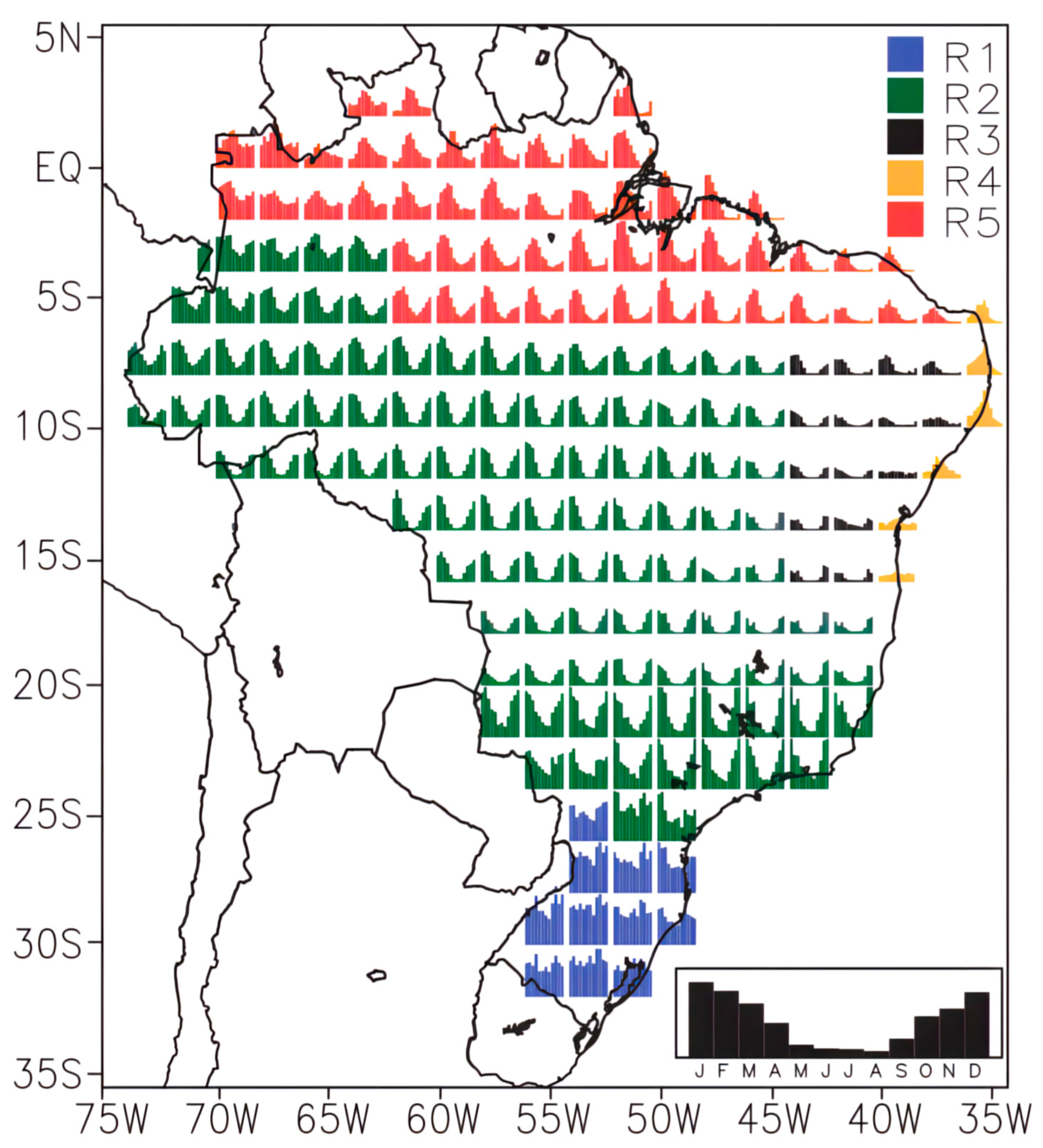


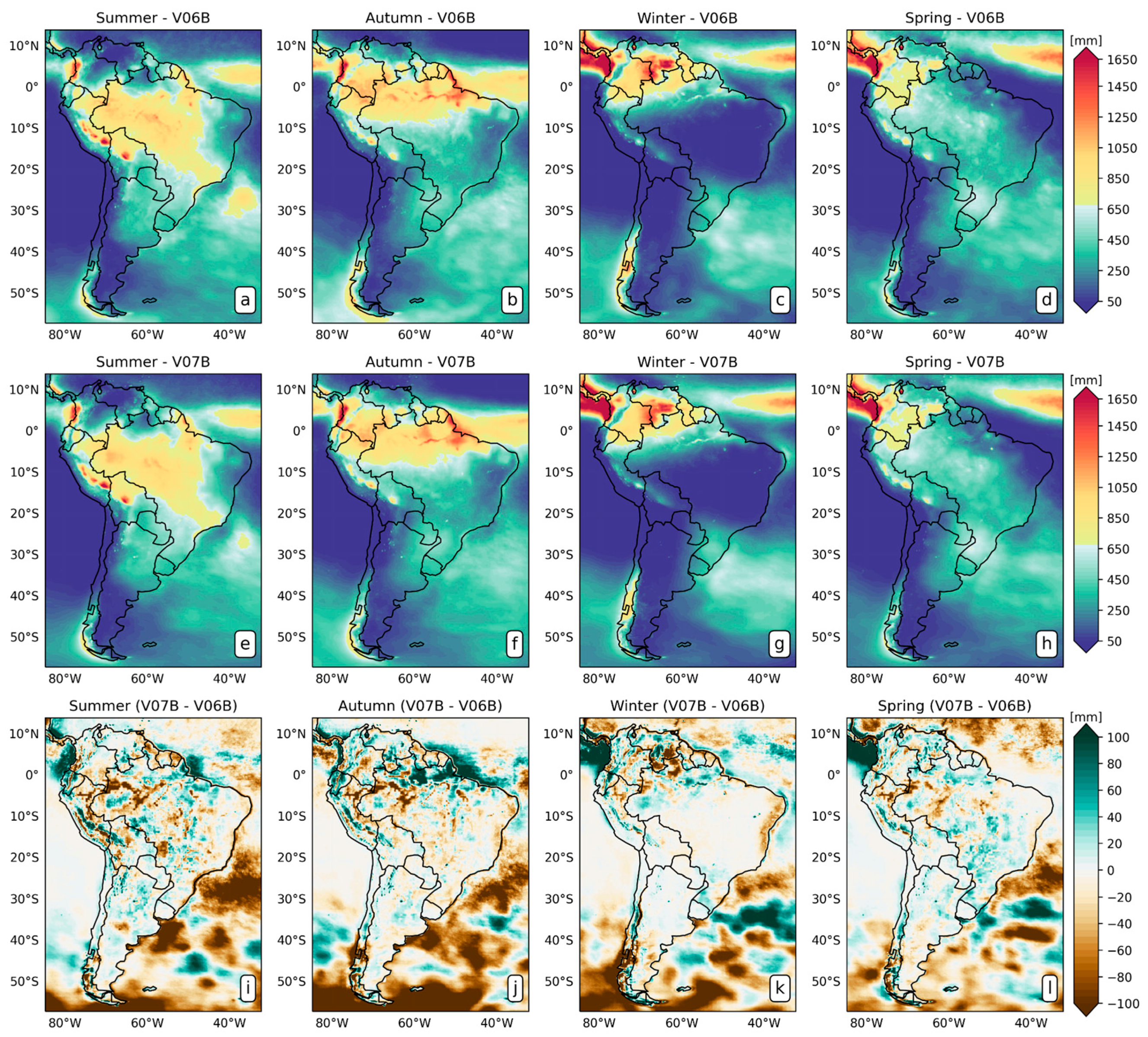
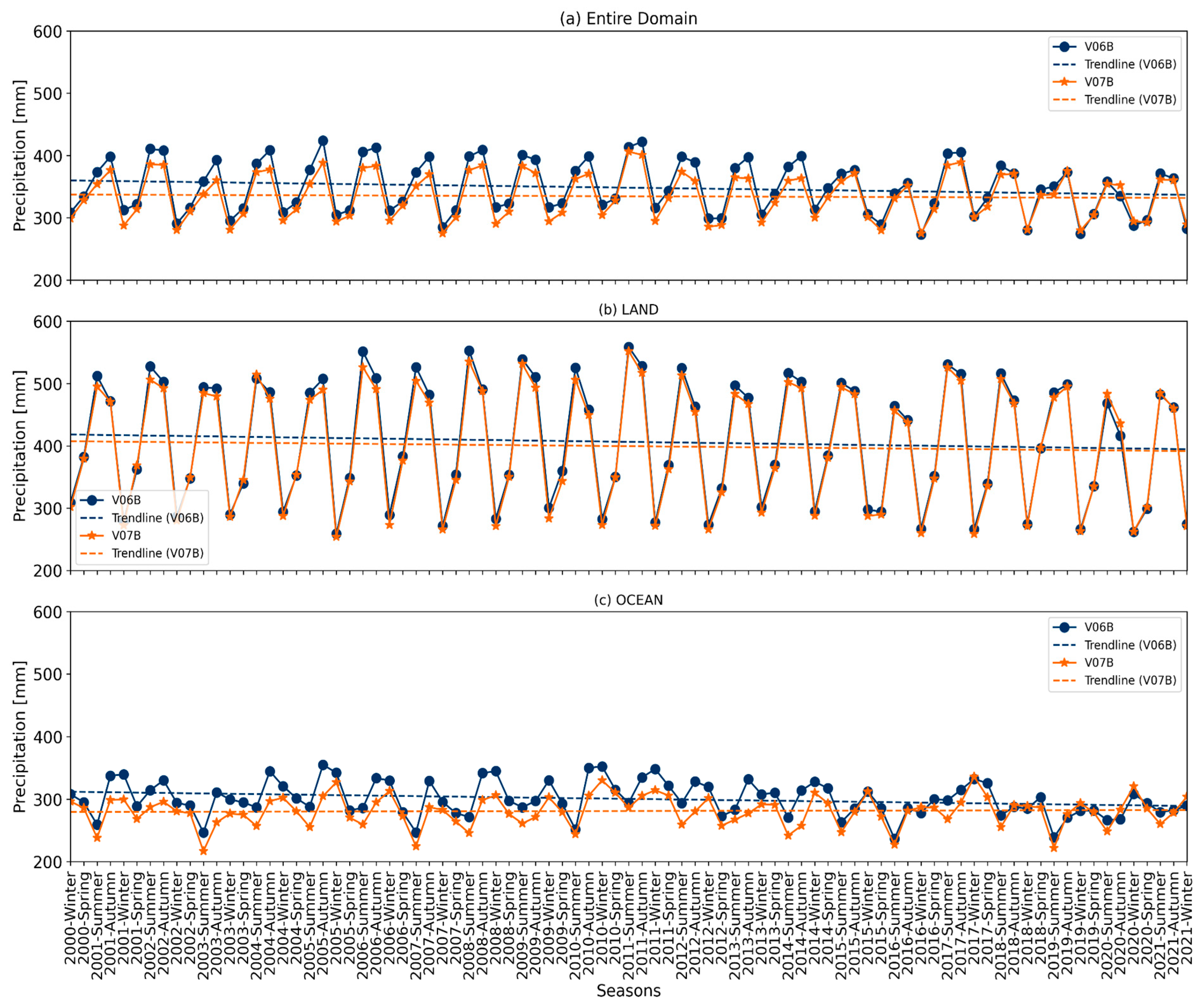
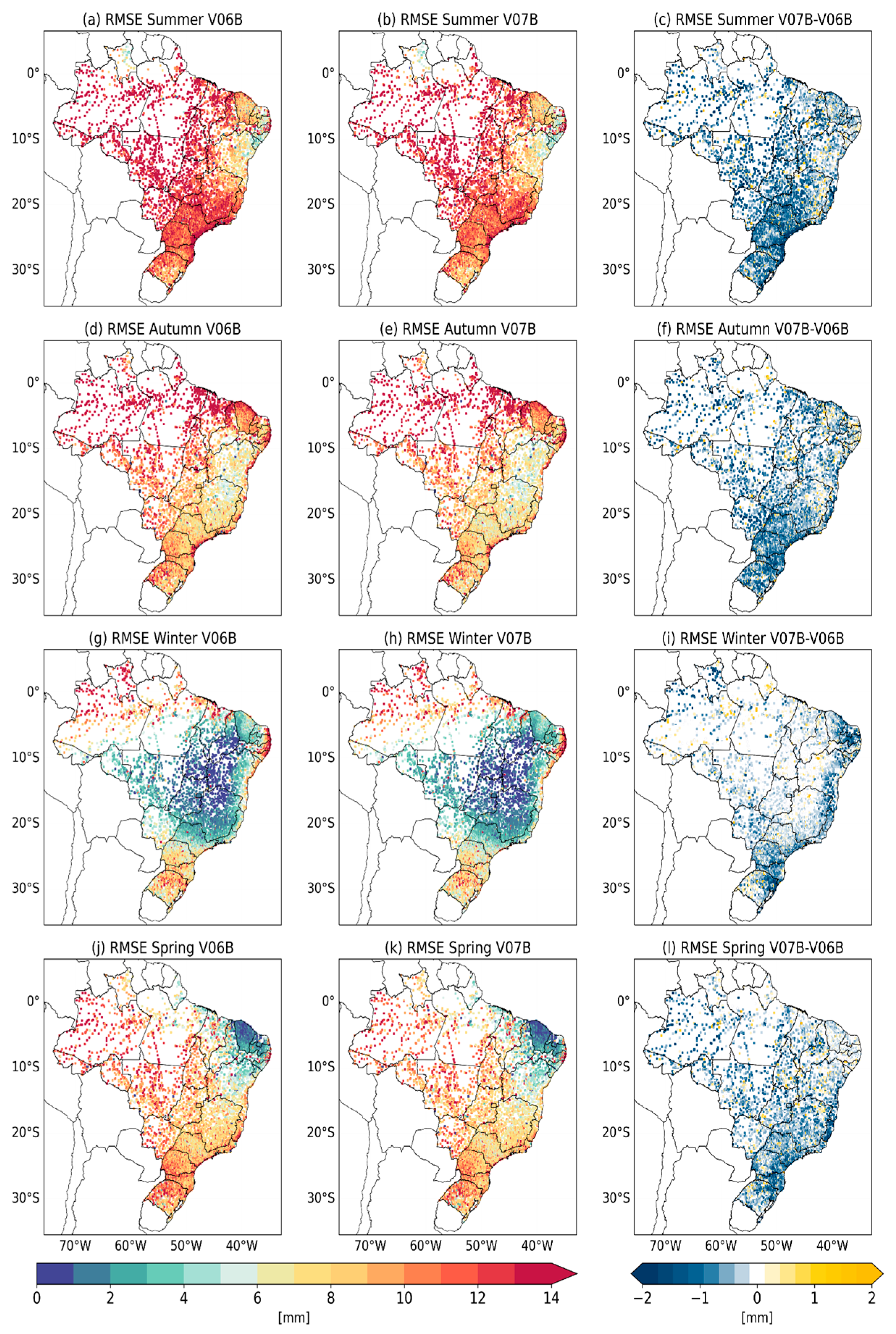


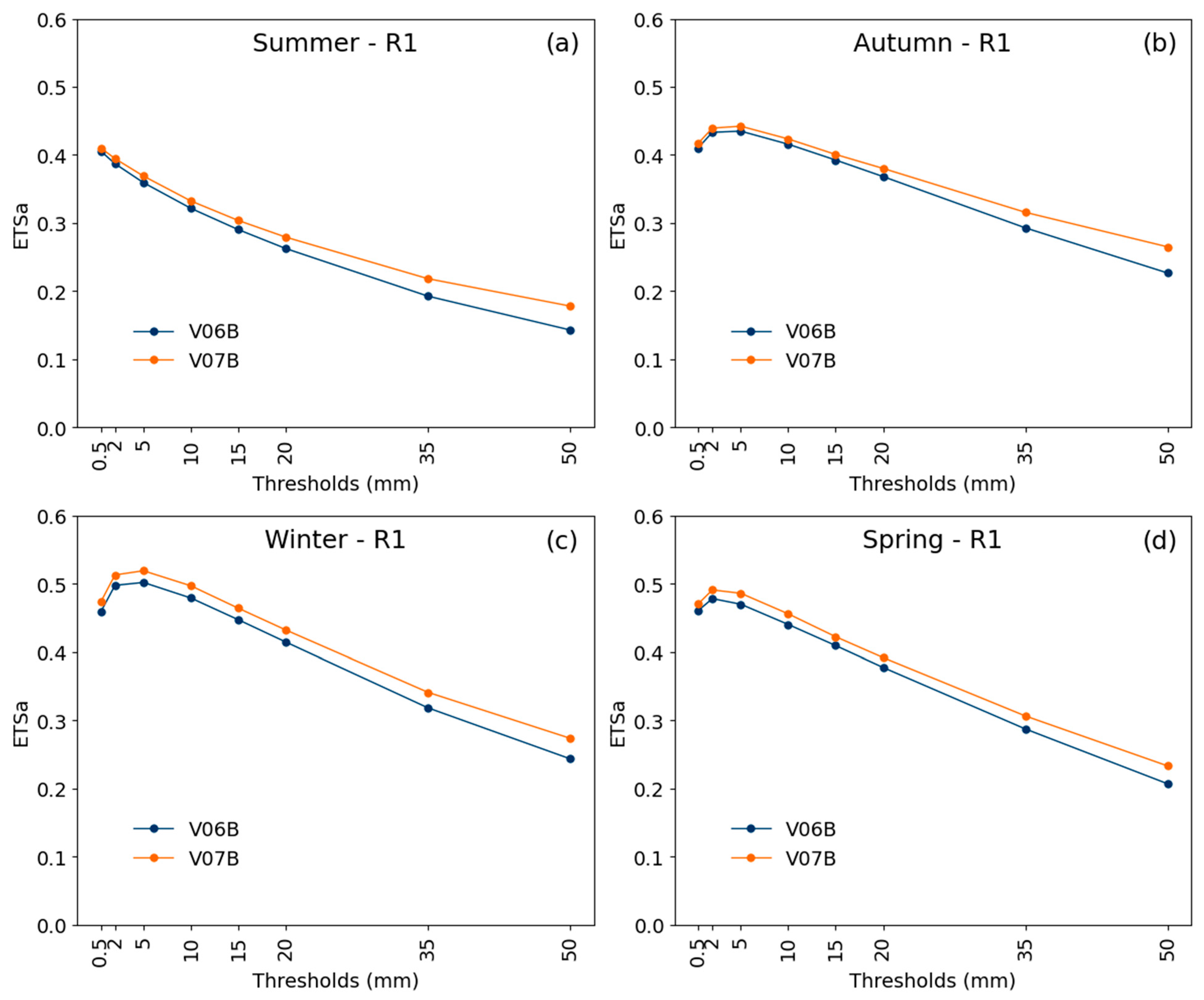
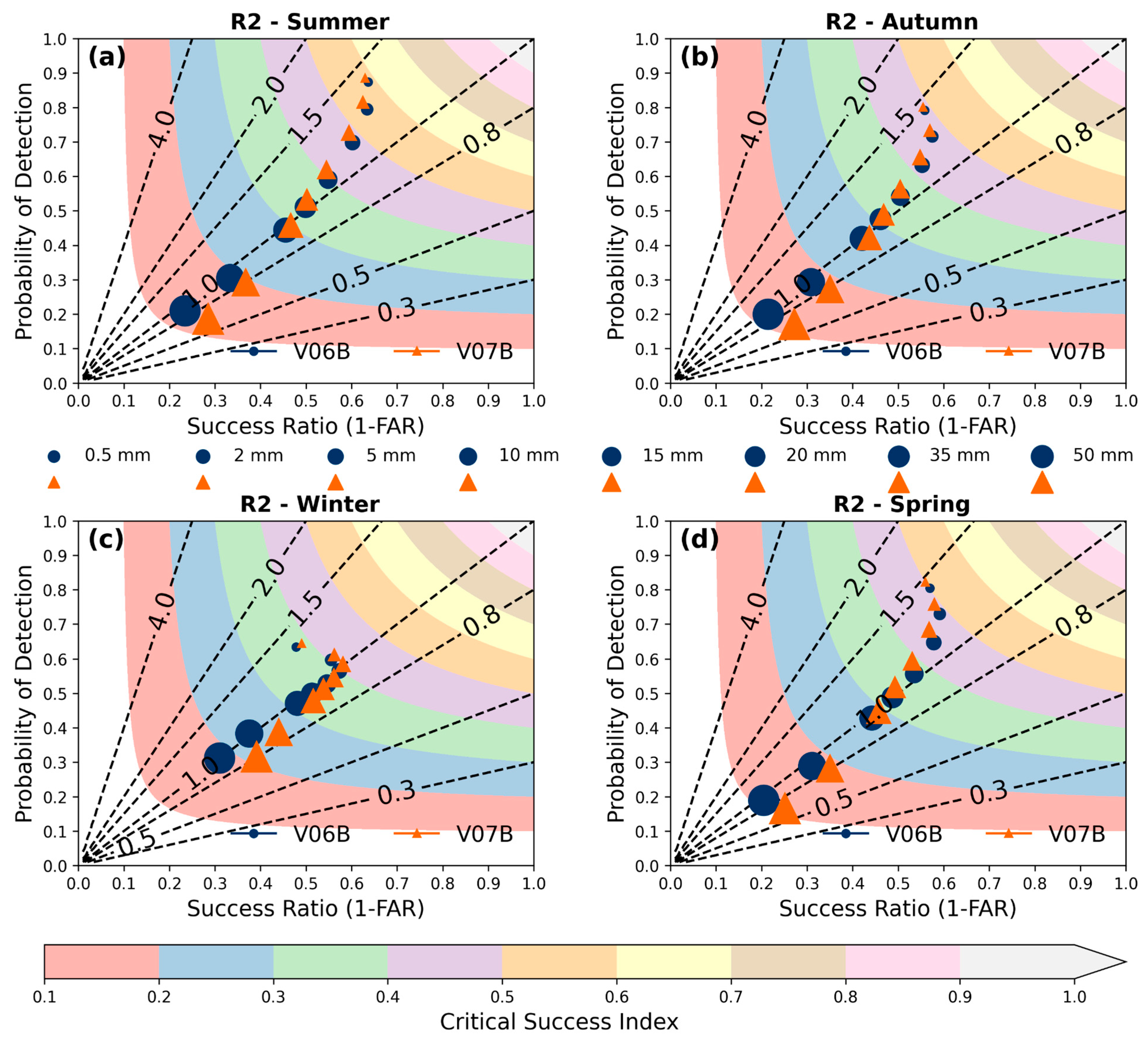
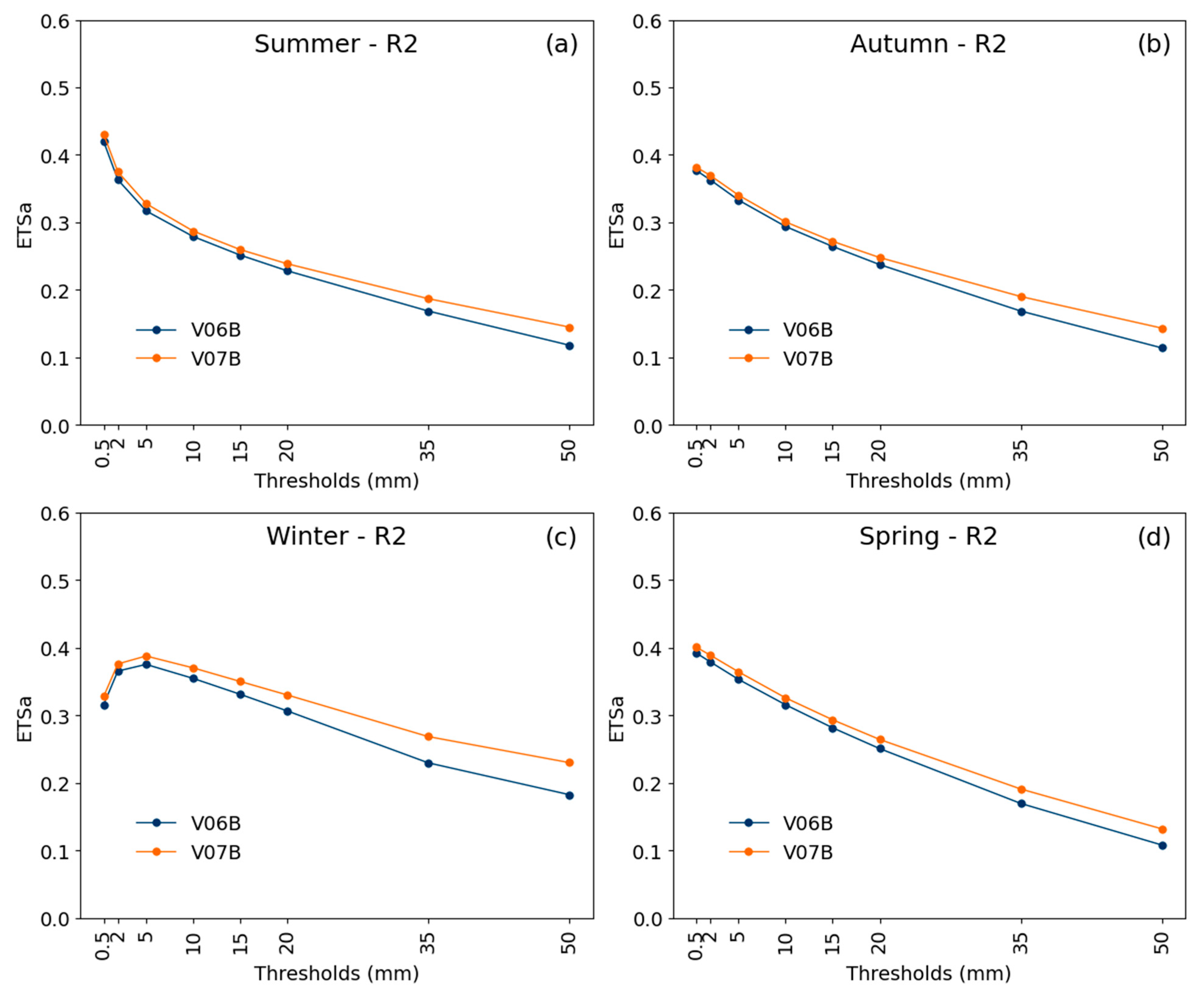
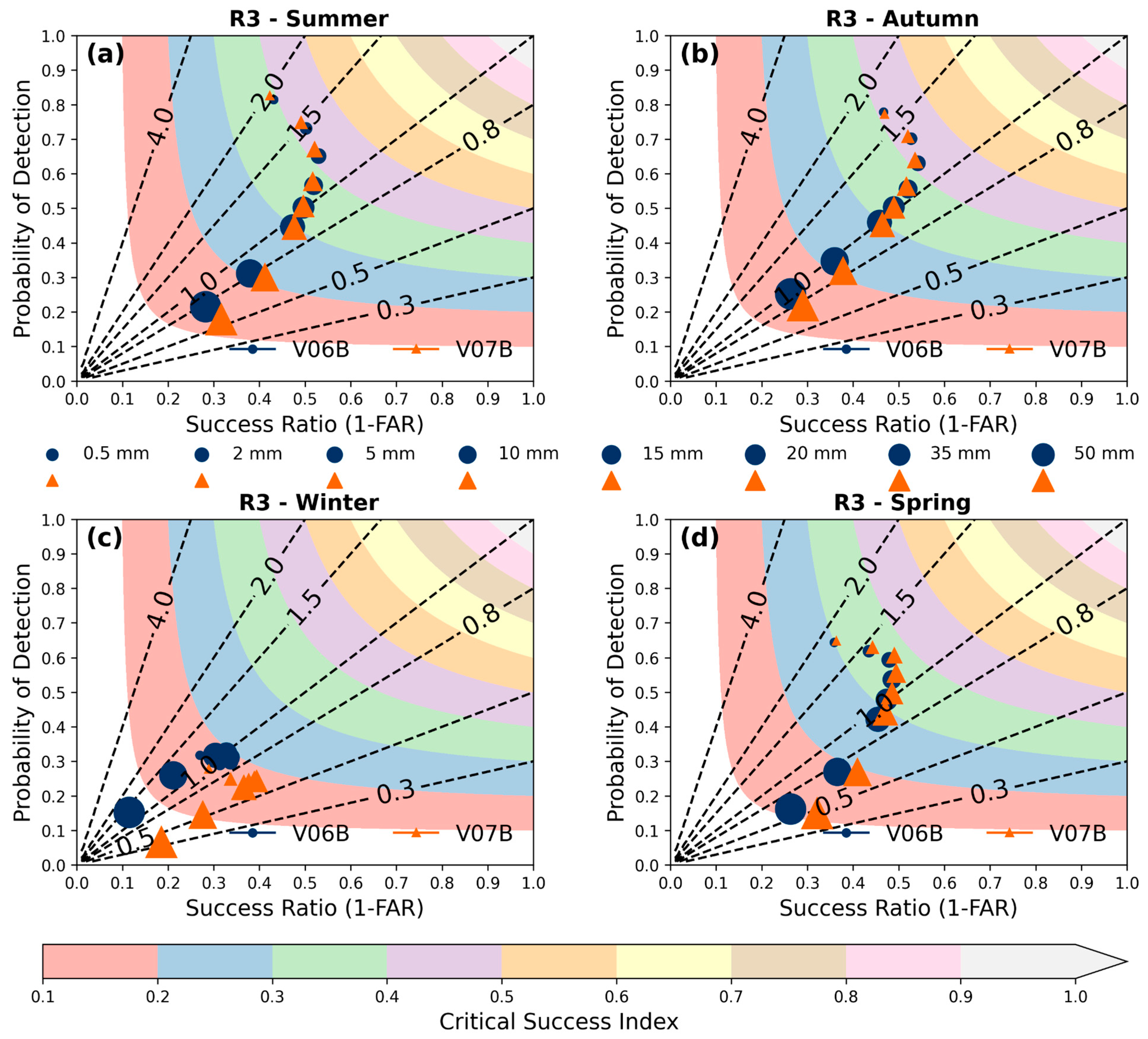
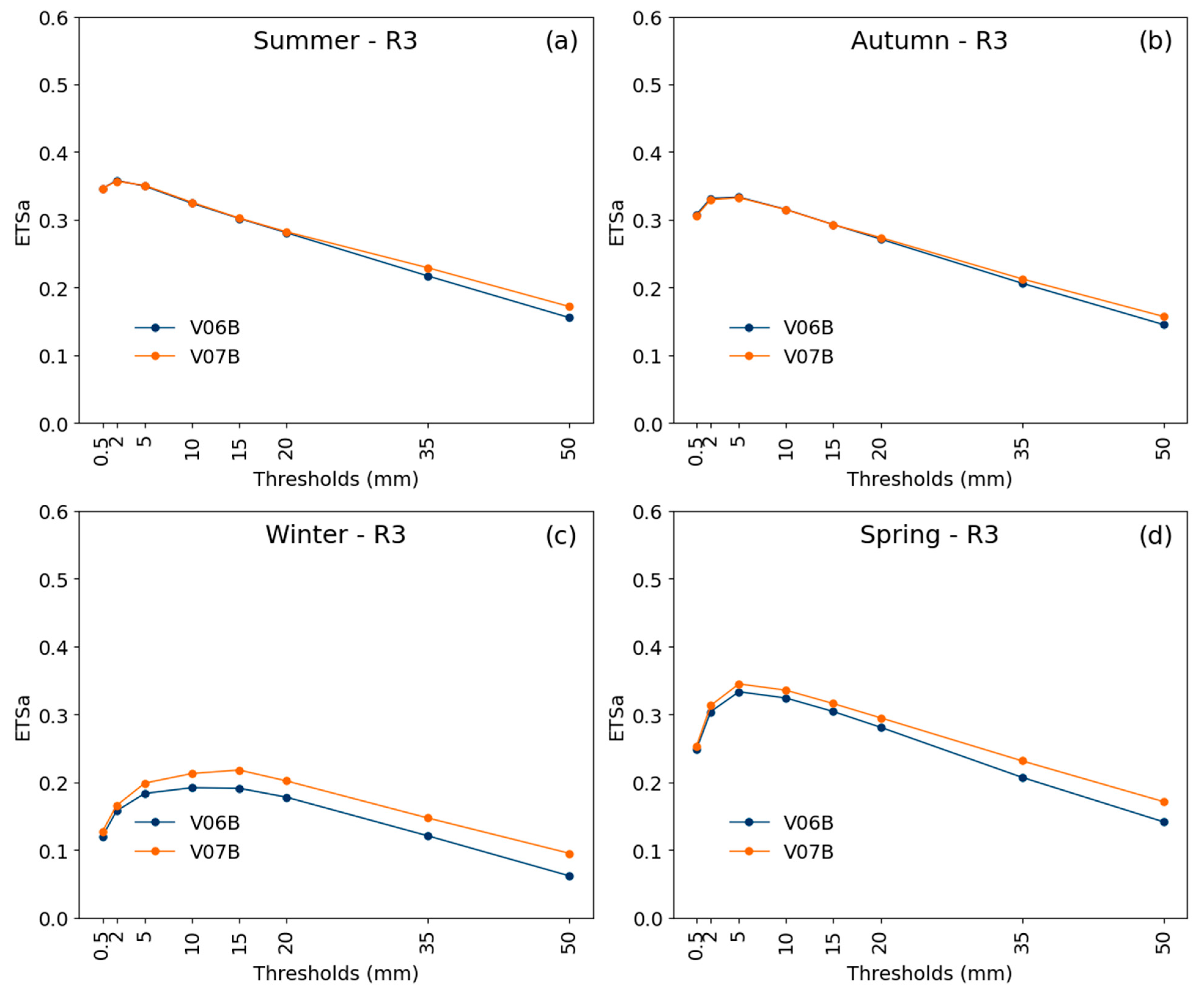
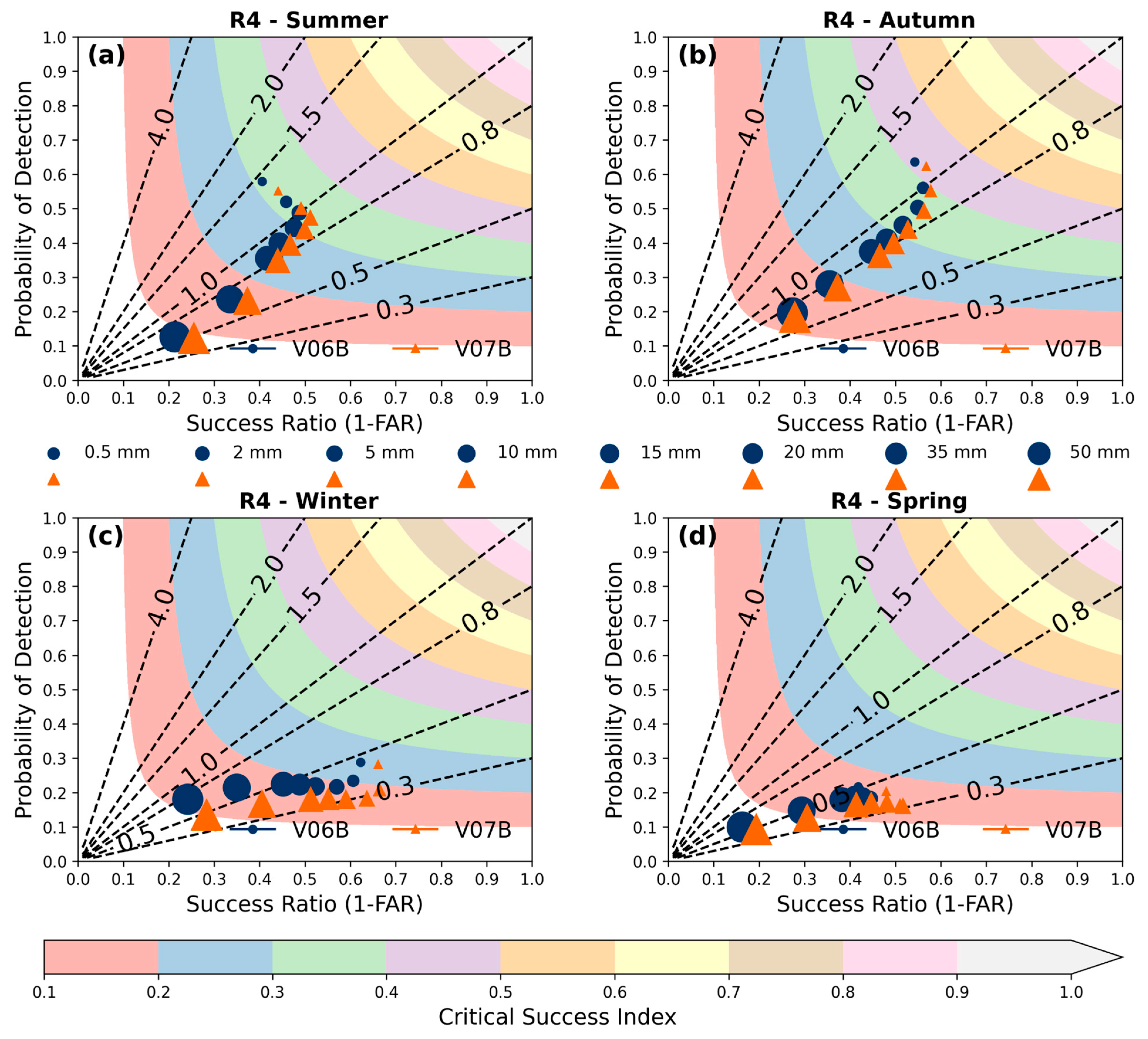
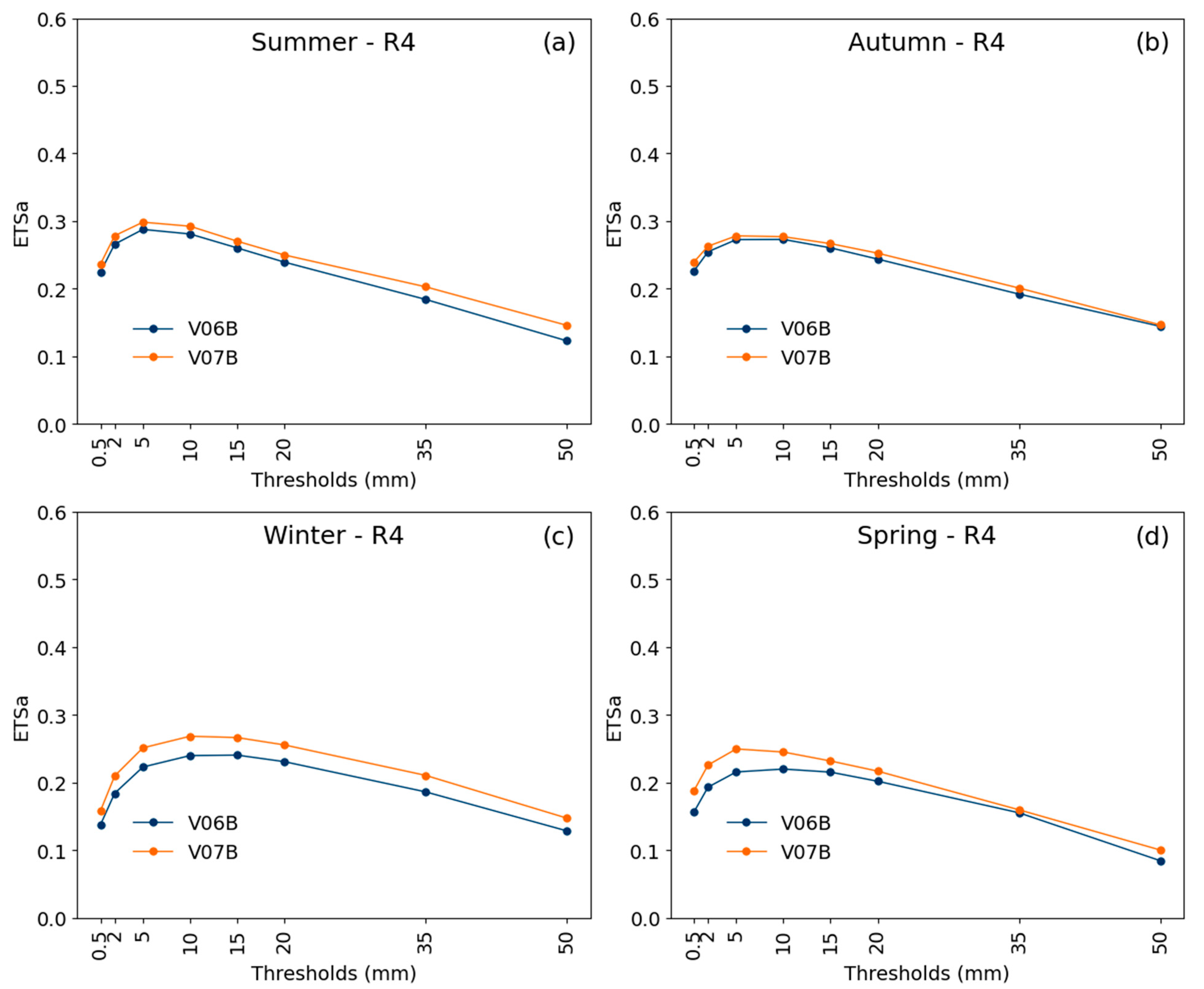
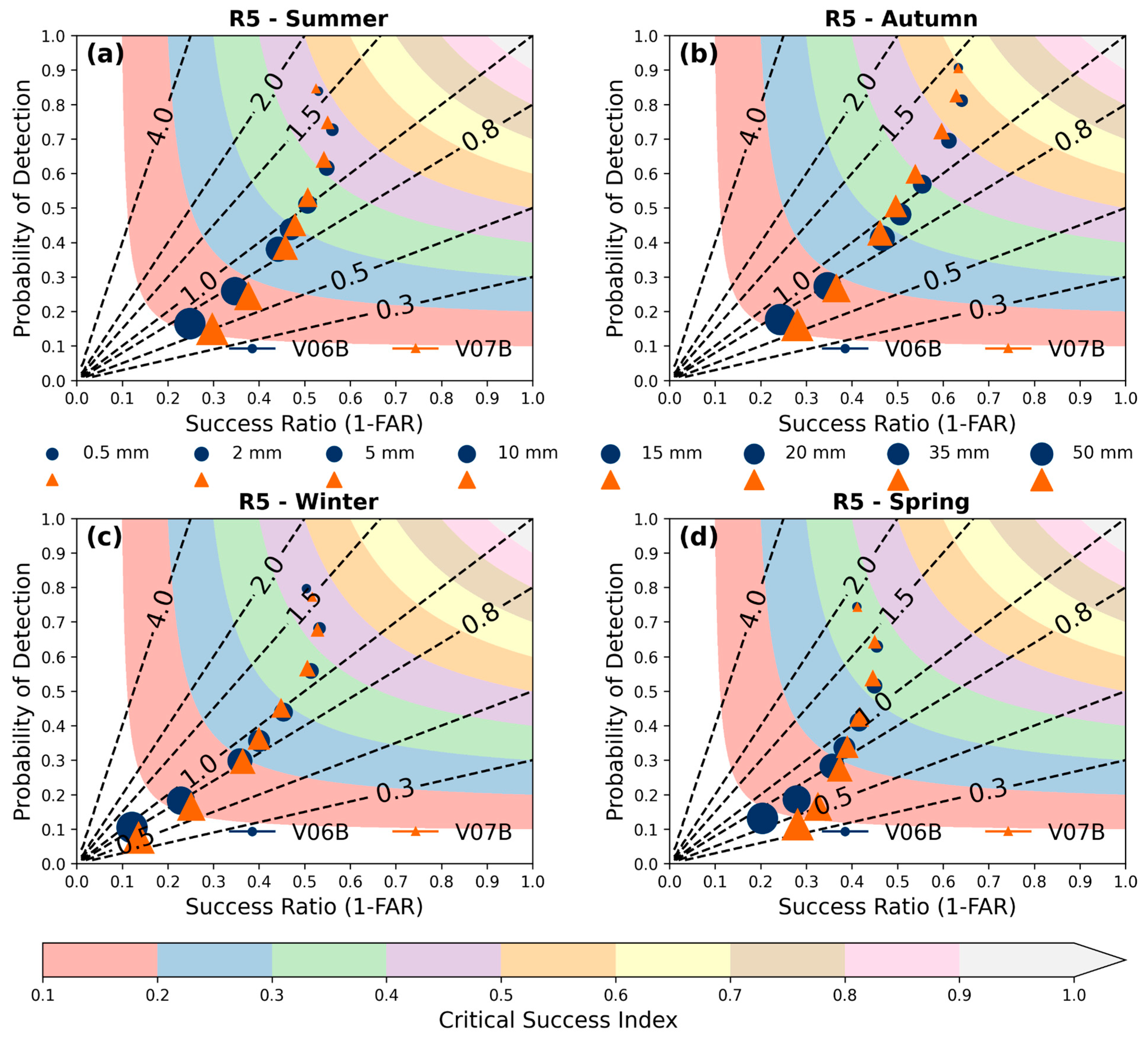

| Statistical Index | Equation | Optimum Value |
|---|---|---|
| Root Mean Square Error | 0 |
| Rain (Gauge) | No Rain (Gauge) | Total | |
| Rain (Precipitation products) | a = H | b | P = (a + b) |
| No rain (Precipitation products) | c | d | (c + d) |
| Total | O = (a + c) | (b + d) | N = (a + b + c + d) |
| Categorical Indices | Equation | Optimum Value |
|---|---|---|
| Adjusted equitable threat score (Mesinger 2008) | where; | 1 |
| Probability of Detection | 1 | |
| False Alarm Ratio | 0 | |
| BIAS | 1 |
| Rain Intensity Classification | Precipitation Thresholds (mm) |
|---|---|
| Rain/no rain | 0.5 |
| Light | 2.0; 5.0 |
| Moderate | 10.0; 20.0 |
| Heavy | 35.0; 50.0 |
Disclaimer/Publisher’s Note: The statements, opinions and data contained in all publications are solely those of the individual author(s) and contributor(s) and not of MDPI and/or the editor(s). MDPI and/or the editor(s) disclaim responsibility for any injury to people or property resulting from any ideas, methods, instructions or products referred to in the content. |
© 2024 by the authors. Licensee MDPI, Basel, Switzerland. This article is an open access article distributed under the terms and conditions of the Creative Commons Attribution (CC BY) license (https://creativecommons.org/licenses/by/4.0/).
Share and Cite
Rozante, J.R.; Rozante, G. IMERG V07B and V06B: A Comparative Study of Precipitation Estimates Across South America with a Detailed Evaluation of Brazilian Rainfall Patterns. Remote Sens. 2024, 16, 4722. https://doi.org/10.3390/rs16244722
Rozante JR, Rozante G. IMERG V07B and V06B: A Comparative Study of Precipitation Estimates Across South America with a Detailed Evaluation of Brazilian Rainfall Patterns. Remote Sensing. 2024; 16(24):4722. https://doi.org/10.3390/rs16244722
Chicago/Turabian StyleRozante, José Roberto, and Gabriela Rozante. 2024. "IMERG V07B and V06B: A Comparative Study of Precipitation Estimates Across South America with a Detailed Evaluation of Brazilian Rainfall Patterns" Remote Sensing 16, no. 24: 4722. https://doi.org/10.3390/rs16244722
APA StyleRozante, J. R., & Rozante, G. (2024). IMERG V07B and V06B: A Comparative Study of Precipitation Estimates Across South America with a Detailed Evaluation of Brazilian Rainfall Patterns. Remote Sensing, 16(24), 4722. https://doi.org/10.3390/rs16244722





